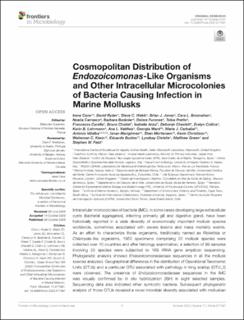Cosmopolitan Distribution of Endozoicomonas-Like Organisms and Other Intracellular Microcolonies of Bacteria Causing Infection in Marine Mollusks
| dc.contributor.author | Cano, Irene | |
| dc.contributor.author | Ryder, David | |
| dc.contributor.author | Webb, Steve C. | |
| dc.contributor.author | Jones, Brian J. | |
| dc.contributor.author | Brosnahan, Cara L. | |
| dc.contributor.author | Carrasco, Noelia | |
| dc.contributor.author | Bodinier, Barbara | |
| dc.contributor.author | Furones, Dolors | |
| dc.contributor.author | Pretto, Tobia | |
| dc.contributor.author | Carella, Francesca | |
| dc.contributor.author | Chollet, Bruno | |
| dc.contributor.author | Arzul, Isabelle | |
| dc.contributor.author | Cheslett, Deborah | |
| dc.contributor.author | Collins, Evelyn | |
| dc.contributor.author | Lohrmann, Karin B. | |
| dc.contributor.author | Valdivia, Ana L. | |
| dc.contributor.author | Ward, Georgia | |
| dc.contributor.author | Carballal, María J. | |
| dc.contributor.author | Villalba, Antonio | |
| dc.contributor.author | Marigómez, Ionan | |
| dc.contributor.author | Mortensen, Stein | |
| dc.contributor.author | Christison, Kevin | |
| dc.contributor.author | Kevin, Wakeman C. | |
| dc.contributor.author | Bustos, Eduardo | |
| dc.contributor.author | Christie, Lyndsay | |
| dc.contributor.author | Green, Matthew | |
| dc.contributor.author | Feist, Stephen W. | |
| dc.date.accessioned | 2020-12-14T11:14:47Z | |
| dc.date.available | 2020-12-14T11:14:47Z | |
| dc.date.created | 2020-12-03T14:23:56Z | |
| dc.date.issued | 2020 | |
| dc.identifier.citation | Frontiers in Microbiology. 2020, 11 1-12. | en_US |
| dc.identifier.issn | 1664-302X | |
| dc.identifier.uri | https://hdl.handle.net/11250/2719126 | |
| dc.description.abstract | Intracellular microcolonies of bacteria (IMC), in some cases developing large extracellular cysts (bacterial aggregates), infecting primarily gill and digestive gland, have been historically reported in a wide diversity of economically important mollusk species worldwide, sometimes associated with severe lesions and mass mortality events. As an effort to characterize those organisms, traditionally named as Rickettsia or Chlamydia-like organisms, 1950 specimens comprising 22 mollusk species were collected over 10 countries and after histology examination, a selection of 99 samples involving 20 species were subjected to 16S rRNA gene amplicon sequencing. Phylogenetic analysis showed Endozoicomonadaceae sequences in all the mollusk species analyzed. Geographical differences in the distribution of Operational Taxonomic Units (OTUs) and a particular OTU associated with pathology in king scallop (OTU_2) were observed. The presence of Endozoicomonadaceae sequences in the IMC was visually confirmed by in situ hybridization (ISH) in eight selected samples. Sequencing data also indicated other symbiotic bacteria. Subsequent phylogenetic analysis of those OTUs revealed a novel microbial diversity associated with molluskan IMC infection distributed among different taxa, including the phylum Spirochetes, the families Anaplasmataceae and Simkaniaceae, the genera Mycoplasma and Francisella, and sulfur-oxidizing endosymbionts. Sequences like Francisella halioticida/philomiragia and Candidatus Brownia rhizoecola were also obtained, however, in the absence of ISH studies, the association between those organisms and the IMCs were not confirmed. The sequences identified in this study will allow for further molecular characterization of the microbial community associated with IMC infection in marine mollusks and their correlation with severity of the lesions to clarify their role as endosymbionts, commensals or true pathogens. | en_US |
| dc.language.iso | eng | en_US |
| dc.title | Cosmopolitan Distribution of Endozoicomonas-Like Organisms and Other Intracellular Microcolonies of Bacteria Causing Infection in Marine Mollusks | en_US |
| dc.type | Peer reviewed | en_US |
| dc.type | Journal article | en_US |
| dc.description.version | publishedVersion | en_US |
| dc.source.pagenumber | 1-12 | en_US |
| dc.source.volume | 11 | en_US |
| dc.source.journal | Frontiers in Microbiology | en_US |
| dc.identifier.doi | 10.3389/fmicb.2020.577481 | |
| dc.identifier.cristin | 1855876 | |
| cristin.ispublished | true | |
| cristin.fulltext | original | |
| cristin.qualitycode | 2 |
Tilhørende fil(er)
Denne innførselen finnes i følgende samling(er)
-
Articles [3012]
-
Publikasjoner fra CRIStin [3066]
